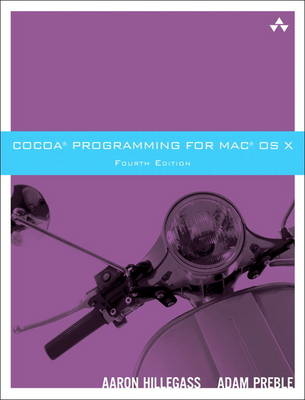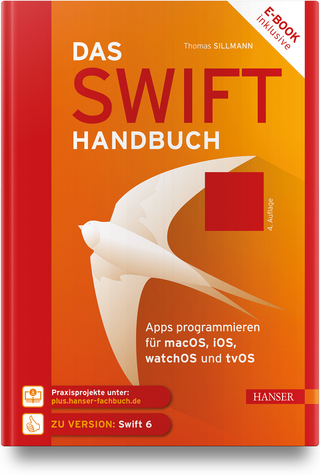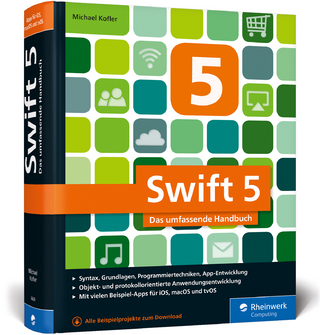
Cocoa Programming for Mac OS X
Addison-Wesley Educational Publishers Inc (Verlag)
978-0-321-77408-8 (ISBN)
- Titel ist leider vergriffen;
keine Neuauflage - Artikel merken
“Cocoa® Programming for Mac® OS X is considered by most to be the de-facto intro-to-OS X programming text.”
—Bob Rudis, the Apple Blog
“I would highly recommend this title to anyone interested in Mac development. Even if you own the previous edition, I think you’ll find the new and revised content well worth the price.”
—Bob McCune, bobmccune.com
If you’re developing applications for Mac OS X, Cocoa® Programming for Mac® OS X, Fourth Edition, is the book you’ve been waiting to get your hands on. If you’re new to the Mac environment, it’s probably the book you’ve been told to read first.
Covering the bulk of what you need to know to develop full-featured applications for OS X, written in an engaging tutorial style, and thoroughly class-tested to assure clarity and accuracy, it is an invaluable resource for any Mac programmer. Specifically, Aaron Hillegass and Adam Preble introduce the two most commonly used Mac developer tools: Xcode and Instruments. They also cover the Objective-C language and the major design patterns of Cocoa. Aaron and Adam illustrate their explanations with exemplary code, written in the idioms of the Cocoa community, to show you how Mac programs should be written. After reading this book, you will know enough to understand and utilize Apple’s online documentation for your own unique needs. And you will know enough to write your own stylish code.
Updated for Mac OS X 10.6 and 10.7, this fourth edition includes coverage of Xcode 4, blocks, view-based table views, Apple’s new approach to memory management (Automatic Reference Counting), and the Mac App Store. This edition adds a new chapter on concurrency and expands coverage of Core Animation. The book now devotes a full chapter to the basics of iOS development.
Aaron Hillegass, who worked at NeXT and Apple, now teaches popular Cocoa programming classes at Big Nerd Ranch. At NeXT, he wrote the first course on OpenStep, the predecessor to today’s Cocoa tools. This book is based on the big Nerd Ranch course and is influenced by more than a decade of work with OpenStep and Cocoa. Adam Preble learned Cocoa programming from the first edition of this book. After too many years of professional C/C++ development, today Adam writes Mac and iOS applications at Big Nerd Ranch, where he is also a Cocoa instructor. He is frequently filling in the gaps between work and family time with pinball machine software development and countless other projects.
Preface xix
Acknowledgments xxi
Chapter 1: Cocoa: What Is It? 1
A Little History 1
Tools 3
Language 4
Objects, Classes, Methods, and Messages 5
Frameworks 6
How to Read This Book 7
Typographical Conventions 7
Common Mistakes 8
How to Learn 8
Chapter 2: Let’s Get Started 11
In Xcode 11
In Interface Builder 15
A Look at Objective-C 25
Documentation 31
What Have You Done? 31
Chronology of an Application 32
Chapter 3: Objective-C 35
Creating and Using Instances 35
Using Existing Classes 37
Creating Your Own Classes 48
The Debugger 58
What Have You Done? 63
Meet the Static Analyzer 63
For the More Curious: How Does Messaging Work? 65
Challenge 66
Chapter 4: Memory Management 67
Living with Manual Reference Counting 69
Accessor Methods 77
Living with ARC 80
Chapter 5: Target/Action 83
Some Commonly Used Subclasses of NSControl 85
Start the SpeakLine Example 89
Lay Out the XIB File 90
Implementing the SpeakLineAppDelegate Class 94
For the More Curious: Setting the Target Programmatically 96
Challenge 96
Debugging Hints 98
Chapter 6: Helper Objects 99
Delegates 100
The NSTableView and Its dataSource 104
Lay Out the User Interface 107
Make Connections 109
Edit SpeakLineAppDelegate.m 110
For the More Curious: How Delegates Work 113
Challenge: Make a Delegate 114
Challenge: Make a Data Source 114
Chapter 7: Key-Value Coding and Key-Value Observing 117
Key-Value Coding 117
Bindings 119
Key-Value Observing 120
Making Keys Observable 121
Properties 124
For the More Curious: Key Paths 126
For the More Curious: Key-Value Observing 127
Chapter 8: NSArrayController 129
Starting the RaiseMan Application 130
Key-Value Coding and nil 139
Add Sorting 140
For the More Curious: Sorting without NSArrayController 141
Challenge 1 142
Challenge 2 142
Chapter 9: NSUndoManager 145
NSInvocation 145
How the NSUndoManager Works 146
Adding Undo to RaiseMan 148
Key-Value Observing 152
Undo for Edits 153
Begin Editing on Insert 156
For the More Curious: Windows and the Undo Manager 158
Chapter 10: Archiving 159
NSCoder and NSCoding 160
The Document Architecture 163
Saving and NSKeyedArchiver 167
Loading and NSKeyedUnarchiver 168
Setting the Extension and Icon for the File Type 170
For the More Curious: Preventing Infinite Loops 172
For the More Curious: Creating a Protocol 173
For the More Curious: Automatic Document Saving 174
For the More Curious: Document-Based Applications without Undo 175
Universal Type Identifiers 175
Chapter 11: Basic Core Data 177
NSManagedObjectModel 177
Interface 179
For the More Curious: View-Based versus Cell-Based Table Views 191
Challenge 191
Chapter 12: NIB Files and NSWindowController 193
NSPanel 193
Adding a Panel to the Application 194
For the More Curious: NSBundle 204
Challenge 206
Chapter 13: User Defaults 207
NSDictionary and NSMutableDictionary 208
NSUserDefaults 210
Setting Defaults 212
Letting the User Edit the Defaults 213
Using the Defaults 215
For the More Curious: NSUserDefaultsController 217
For the More Curious: Reading and Writing Defaults from the Command Line 217
Challenge 219
Chapter 14: Using Notifications 221
What Notifications Are and Are Not 221
What Notifications Are Not 222
NSNotification 222
NSNotificationCenter 222
Posting a Notification 224
Registering as an Observer 225
Handling the Notification When It Arrives 226
The userInfo Dictionary 226
For the More Curious: Delegates and Notifications 227
Challenge 228
Chapter 15: Using Alert Panels 229
Make the User Confirm the Deletion 230
Challenge 232
Chapter 16: Localization 233
Localizing a NIB File 234
String Tables 236
For the More Curious: ibtool 239
For the More Curious: Explicit Ordering of Tokens in Format Strings 240
Chapter 17: Custom Views 241
The View Hierarchy 241
Get a View to Draw Itself 243
Drawing with NSBezierPath 248
NSScrollView 250
Creating Views Programmatically 252
For the More Curious: Cells 253
For the More Curious: isFlipped 255
Challenge 255
Chapter 18: Images and Mouse Events 257
NSResponder 257
NSEvent 257
Getting Mouse Events 259
Using NSOpenPanel 259
Composite an Image onto Your View 264
The View’s Coordinate System 266
Autoscrolling 268
For the More Curious: NSImage 269
Challenge 270
Chapter 19: Keyboard Events 271
NSResponder 273
NSEvent 273
Create a New Project with a Custom View 274
For the More Curious: Rollovers 282
The Fuzzy Blue Box 284
Chapter 20: Drawing Text with Attributes 285
NSFont 285
NSAttributedString 286
Drawing Strings and Attributed Strings 289
Making Letters Appear 289
Getting Your View to Generate PDF Data 291
For the More Curious: NSFontManager 293
Challenge 1 293
Challenge 2 294
Chapter 21: Pasteboards and Nil-Targeted Actions 295
NSPasteboard 296
Add Cut, Copy, and Paste to BigLetterView 298
Nil-Targeted Actions 300
For the More Curious: Which Object Sends the Action Message? 303
For the More Curious: UTIs and the Pasteboard 303
For the More Curious: Lazy Copying 304
Challenge 1 305
Challenge 2 305
Chapter 22: Categories 307
Add a Method to NSString 307
For the More Curious: Declaring Private Methods 309
Chapter 23: Drag-and-Drop 311
Make BigLetterView a Drag Source 312
Make BigLetterView a Drag Destination 315
For the More Curious: Operation Mask 319
Chapter 24: NSTimer 321
Lay Out the Interface 323
Make Connections 325
Add Code to TutorController 326
For the More Curious: NSRunLoop 328
Challenge 328
Chapter 25: Sheets 329
Adding a Sheet 330
For the More Curious: contextInfo 335
For the More Curious: Modal Windows 336
Chapter 26: Creating NSFormatters 339
A Basic Formatter 341
The Delegate of the NSControl Class 347
Checking Partial Strings 348
Formatters That Return Attributed Strings 350
For the More Curious: NSValueTransformer 351
Chapter 27: Printing 353
Dealing with Pagination 353
For the More Curious: Are You Drawing to the Screen? 358
Challenge 358
Chapter 28: Web Services 359
RanchForecast Project 360
Opening URLs 368
Challenge: Add a WebView 369
Chapter 29: Blocks 371
Block Syntax 373
Challenge: Design a Delegate 381
Chapter 30: Developing for iOS 383
Porting RanchForecast to iOS 383
RootViewController 386
Add a Navigation Controller 388
ScheduleViewController 391
UITableViewController 392
Pushing View Controllers 393
Challenge 395
Chapter 31: View Swapping 397
Get Started 398
Add View Swapping to MyDocument 401
Resizing the Window 403
Chapter 32: Core Data Relationships 407
Edit the Model 407
Create Custom NSManagedObject Classes 409
Lay Out the Interface 411
EmployeeView.xib 413
Events and nextResponder 414
Chapter 33: Core Animation 417
Scattered 417
Implicit Animation and Actions 423
Challenge 1 425
Challenge 2 425
Chapter 34: Concurrency 427
Multithreading 427
Improving Scattered: Time Profiling in Instruments 431
NSOperationQueue 435
For the More Curious: Faster Scattered 438
Challenge 439
Chapter 35: Cocoa and OpenGL 441
A Simple Cocoa/OpenGL Application 442
Chapter 36: NSTask 451
ZIPspector 451
Challenge: .tar and .tgz files 460
Chapter 37: Distributing Your App 461
Build Configurations 461
Creating a Release Build 464
Application Sandboxing 466
The Mac App Store 468
Chapter 38: The End 471
Index 473
| Erscheint lt. Verlag | 23.11.2011 |
|---|---|
| Verlagsort | New Jersey |
| Sprache | englisch |
| Maße | 179 x 231 mm |
| Gewicht | 838 g |
| Themenwelt | Informatik ► Programmiersprachen / -werkzeuge ► Mac / Cocoa Programmierung |
| ISBN-10 | 0-321-77408-6 / 0321774086 |
| ISBN-13 | 978-0-321-77408-8 / 9780321774088 |
| Zustand | Neuware |
| Informationen gemäß Produktsicherheitsverordnung (GPSR) | |
| Haben Sie eine Frage zum Produkt? |
aus dem Bereich

